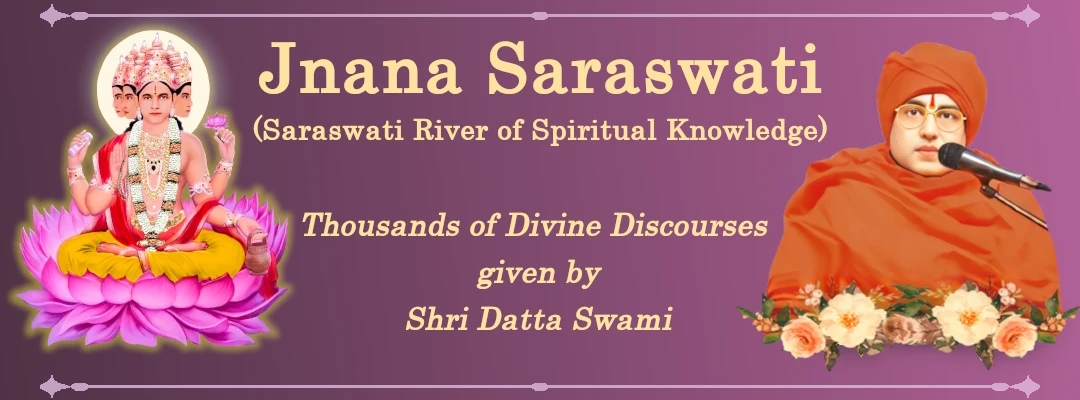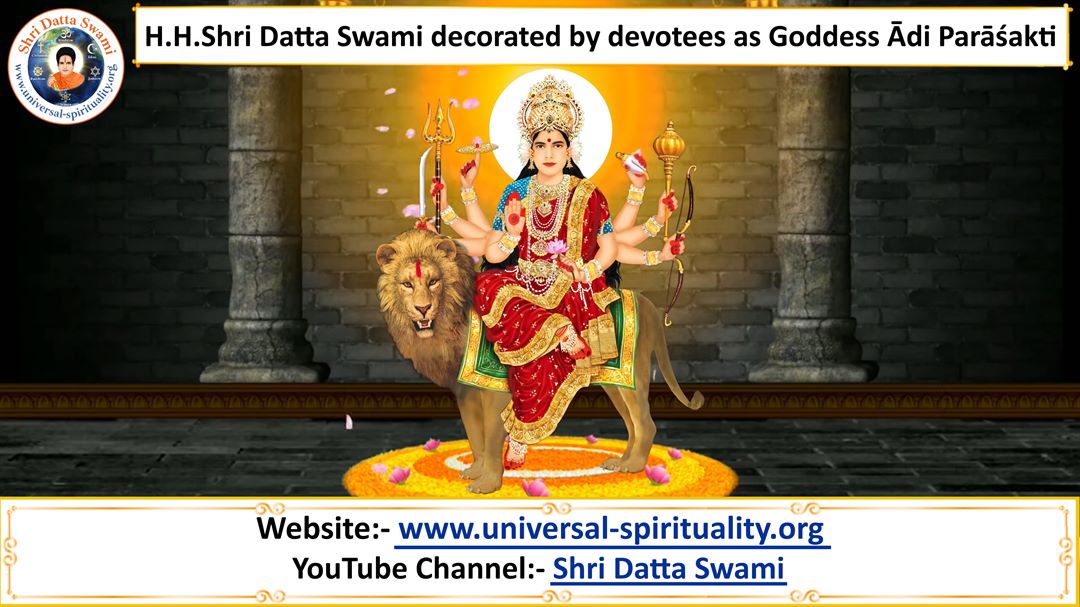
06 May 2024
[Smt. Chhandaa Chandra asked:- In one discourse, You told the subtle energy called space, which is the first creation as Aadishakti. Is it not correct to call Divine Mother Durgaa as Aadishakti or Aadiparaashakti?]
Swami replied:- Space and Durgaa are the fixed names of specific items. Space is the first energy and hence, space can be called as Aadishakti (Aadi = first, Shakti = energy). The words like Aadishakti or Aadiparaashakti are only adjective nouns, which are not fixed names (primary nouns) of any specific items. Suppose that you have switched on a light today for the first time. You can call such light as Aadishakti. In this context, the word is meaningful. You must not arrive at items and contexts based on words like Aadishakti, Aadiparaashakti, etc. You must arrive at these words starting from fixed contexts and fixed specific items. If you base yourself on such adjective nouns and try to arrive at the contexts and specific items, confusion blasts your mind like a bomb working on fusion principle! Scripture says that trying to understand the subject based on adjective nouns leads you to a lot of confusion like a deep forest (Śabda jāla mahāraṇyam, citta bhramaṇa kāraṇam). Durgaa or Anaghaa or Maayaa Shakti means the divine power of the unimaginable God or God Datta. Space is called as Prakruti Shakti. Maayaa represents the causal state and Prakruti represents the state of product. Again, the word like ‘Primordial Energy’ is also an adjective noun. Adjective noun means the associated characteristic whereas the primary noun is the inherent characteristic. In the word ‘wet-lotus’, the word ‘wet’ is adjective noun and the word ‘lotus’ is the primary noun. Always, fix your mind on the specific items indicated by the primary nouns and then, you can use the adjective nouns as per the context. ‘Lotus’ means only lotus flower. ‘Wet’ means any item that is associated with moisture.

If you analyze creation or product, space is subtle energy whereas fire is gross energy. This subtle energy on condensation becomes matter. This subtle energy becomes awareness, which is a specific work form and the specific nature of awareness is due to the design of the brain-nervous system. The difference between matter and awareness is that matter is a direct condensed form of inert energy whereas awareness is an indirect form of inert energy because the nature of awareness is introduced by the design of the nervous system. Awareness is not introduced by the inert energy itself since the inert energy itself is not non-inert. The subtle energy becomes non-inert awareness, inert matter and inert gross energy. We can compare the source (subtle energy) to the Divine Mother Durgaa or Mahaa Kaali from whom the awareness (Goddess Saraswati), the matter (Goddess Lakshmi) and the gross energy (Goddess Parvati) are evolved. Knowledge based on awareness is related to Saraswati. Matter denoting wealth is related to Lakshmi. Gross energy (like light, heat, electricity, magnetism, etc.) is related to Parvati. The source or subtle energy and the third form or gross energy are represented by a wave (energy) and this wave is represented by the Shiva Lingam or God Shiva. This is the internal meaning in saying that God Shiva is the husband of Durgaa or Mahaa Kaali or Parvati. But, remember that all this is the description of creation only and God Shiva or Durgaa or Mahaa Kaali or Parvati or Saraswati or Lakshmi is only taken as the simile in explaining the concept of creation. You should not say that creation itself is Durgaa because we have the awareness (Saraswati), the wealth (Lakshmi) and the destructive radiation power (Parvati) in the creation itself. These three aspects of creation are limited and cannot be the infinite divine powers. The soul is having little knowing awareness in a limited way (alpajna caitanya shakti) whereas the power of God is unlimited (sarvajna caitanya shakti) knowing everything. Similarly with the other two powers as well. You can say that matter and gross energy are direct forms of subtle energy because the inherent nature of the inert subtle energy itself became the inert nature of matter and gross energy. Regarding awareness, the resulting awareness is non-inert and hence, the contribution of the design of the nervous system develops the non-inert nature of awareness.
Coming to the causal state or the state of creator, there is the foremost and ultimate unmediated unimaginable God or Parabrahman. The unimaginable power of this God is Durgaa or Mahaa Kaali or Maayaa Shakti. In fact, you cannot speak about the existence of Parabrahman and Maayaa Shakti separately since both are unimaginable items. The school of Vedanta speaks the cause as Parabrahman whereas the school of Shaakteyaas speaks the same cause as Maayaa Shakti. Hence, both these schools are alternative schools only and not two schools including each other. This power of Maayaa Shakti can be called as Aadishakti because it is the causal power (Aadi means first or cause). This Maayaa Shakti can be called as Aadiparaashakti (Aadiparaashakti means the power of awareness) because this unimaginable power is not inert since it is aware of everything (Sarvajna Caitanya Shakti or omniscient awareness). This power is not inert like the above-mentioned subtle energy belonging to product or creation.
Opponent:- When You said that this power is in causal state, there is no inert energy and materialized nervous system before creation, how can You say that this omniscient awareness existed before creation?
Shri Datta Swami:- For this power to think about creating the world, awareness generated in creation (Prakruti Shakti or Paraa Prakruti) is not needed because this power is omnipotent. Based on its nature of omnipotency, it can think even without the awareness mentioned in the creation. Hence, this power can also be called as Aadiparaashakti. As per the Shaakteya-School, the word ‘Maayaa Shakti’ is used for the omnipotent cause. As per the school of Vedanta, we can use the word ‘Parabrahman’ for the same omnipotent cause.
The final advice is that you should not be confused by the adjective nouns in recognizing the specific items since you have to use these adjective nouns as per the context only after recognizing the specific items by primary nouns.
We have both the words ‘Muula Maayaa’ and ‘Muula Prakruti’. Here, the first word called Muula Maayaa belongs to the causal state (creator) and the second word called Muula Prakruti belongs to the state of product (creation). The atheistic Saamkhya philosophy says that Muula Prakruti is the cause of creation without any reference to God (Mūla prakṛti ravikṛtiḥ). They say that this Muula Prakruti is an equilibrium state of three qualities (sattvam, rajas and tamas) and the disturbance in the equilibrium leads to creation. This is not acceptable since the original subtle energy is inert and not at all having any awareness or sattvam. Even if we consider the process of generation of awareness from subtle energy, the contribution of nervous system is much more than the contribution of inherent nature of the subtle energy. Hence, this concept is not logical in anyway. The word ‘Prakruti’ can mean both causal state and state of product as per its etymological meaning. Prakruti denoting causal state is drawn from the meaning that Prakruti means the divine power by which all this creation is created (Prakṛṣṭaṃ kriyate anayā iti prakṛtiḥ). Prakruti denoting the state of product or creation is drawn from the meaning that Prakruti means the best product (creation) created by the causal power (Prakṛṣṭā ca kṛtiḥ sṛṣṭiḥ iti prakṛtiḥ). Similarly, the word Maayaa can mean both cause and product. The etymological meaning of the word Maayaa is that it is wonderful (Maya-vaicitrye). The cause, which is unimaginable God, is wonderful due to His omnipotency and His creation is also wonderful. One should be careful about this concept also, which is an internal confusion in the above external confusion like a cinema played in the cinema itself.
★ ★ ★ ★ ★